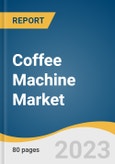The global Coffee Machine market size is expected to reach USD 9.26 billion by 2030, registering a CAGR of 4.7% during the forecast period. With the increasing number of discerning consumers and evolving palate for gourmet varieties, the demand for specialty beverages including coffee has grown significantly in the past few decades. This factor is expected to drive the growth of the market. Coffee is known to reduce the risk of liver diseases, cardiac failure, and type 2 diabetes. This factor will boost the consumption of coffee, ultimately contributing to the growth of the coffee machine market. Higher repair and maintenance cost is the major restraint for the growth.
The COVID-19 pandemic negatively impacted the growth of the market. Most leading brands experienced a slight decline in sales due to the pandemic. The lockdown in China has forced coffee machine manufacturers based in the U.S. and Europe to halt production as they export several input supplies temporarily. Despite threats posed by the economic implications of the COVID-19 outbreak at the start of 2020, the food service sector is gradually recovering presenting a positive outlook for the coffee machine industry.
The drip filter segment held the largest market share in 2022. As these machines are more affordable as compared to espresso types of machines. Moreover, minimum repair & maintenance costs and ample features of the drip filter machines are some of the factors that are driving the growth of the segment. Thus, it is mostly used all over the world and generated large revenue in 2022.
Europe acquired the largest revenue share in 2022. In the German automatic coffee machine industry, manufacturers are highly focused to offer products that are energy efficient. The European regulations drafted for household appliances are focused to reduce greenhouse gas (GHG) emissions and electricity consumption. Increased preference of consumers for the premiumization of coffee machines drives the market in Europe. Thus, the region generated maximum revenue in 2022.
Major market players includeKeurig Green Mountain, Inc.; Panasonic Malaysia; Nestlé Nespresso S.A.; De’Longhi Appliances S.r.l.; Electrolux; Morphy Richards India; Koninklijke Philips N.V.; Hamilton Beach Brands, Inc.; Schaerer; and Robert Bosch GmbH. The manufacturers are focusing on developing coffee machines with Wi-Fi connectivity, voice assistance, etc. Such machines wirelessly connect to smartphones, Bluetooth or Wi-Fi.
The COVID-19 pandemic negatively impacted the growth of the market. Most leading brands experienced a slight decline in sales due to the pandemic. The lockdown in China has forced coffee machine manufacturers based in the U.S. and Europe to halt production as they export several input supplies temporarily. Despite threats posed by the economic implications of the COVID-19 outbreak at the start of 2020, the food service sector is gradually recovering presenting a positive outlook for the coffee machine industry.
The drip filter segment held the largest market share in 2022. As these machines are more affordable as compared to espresso types of machines. Moreover, minimum repair & maintenance costs and ample features of the drip filter machines are some of the factors that are driving the growth of the segment. Thus, it is mostly used all over the world and generated large revenue in 2022.
Europe acquired the largest revenue share in 2022. In the German automatic coffee machine industry, manufacturers are highly focused to offer products that are energy efficient. The European regulations drafted for household appliances are focused to reduce greenhouse gas (GHG) emissions and electricity consumption. Increased preference of consumers for the premiumization of coffee machines drives the market in Europe. Thus, the region generated maximum revenue in 2022.
Major market players includeKeurig Green Mountain, Inc.; Panasonic Malaysia; Nestlé Nespresso S.A.; De’Longhi Appliances S.r.l.; Electrolux; Morphy Richards India; Koninklijke Philips N.V.; Hamilton Beach Brands, Inc.; Schaerer; and Robert Bosch GmbH. The manufacturers are focusing on developing coffee machines with Wi-Fi connectivity, voice assistance, etc. Such machines wirelessly connect to smartphones, Bluetooth or Wi-Fi.
Coffee Machine Market Report Highlights
- Asia Pacific is expected to dominate the market from 2023 to 2030. An increasing number of coffee shops and cafes in the region is likely to grow the regional growth
- The pod/capsule segment is likely to dominate over the forecast period. The acceptance of sustainable coffee pods by manufacturers is expected to grow prospects of the coffee pods landscape and help alter consumer perception regarding coffee pods
- The residential segment is likely to dominate over the forecast period. Technological advancements in coffee machines are anticipated to propel the segment’s growth
Table of Contents
Chapter 1. Methodology and Scope
Chapter 2. Executive Summary
Chapter 3. Coffee Machine Market Variables, Trends & Scope
Chapter 4. Consumer Behavior Analysis
Chapter 5. Coffee Machine Market: Product type Estimates & Trend Analysis
Chapter 6. Coffee Machine Market: Application Estimates & Trend Analysis
Chapter 7. Coffee Machine Market: Regional Estimates & Trend Analysis
Chapter 8. Competitive Analysis
List of Tables
List of Figures
Companies Mentioned
- Keurig Green Mountain, Inc.
- Panasonic Malaysia
- Nestlé Nespresso S.A.
- De’Longhi Appliances S.R.L.
- Electrolux
- Morphy Richards India
- Koninklijke Philips N.V.
- Hamilton Beach Brands, Inc.
- Schaerer
- Robert Bosch Gmbh
Methodology

LOADING...
Table Information
| Report Attribute | Details |
|---|---|
| No. of Pages | 80 |
| Published | July 2023 |
| Forecast Period | 2022 - 2030 |
| Estimated Market Value ( USD | $ 6.41 billion |
| Forecasted Market Value ( USD | $ 9.26 billion |
| Compound Annual Growth Rate | 4.7% |
| Regions Covered | Global |
| No. of Companies Mentioned | 10 |









